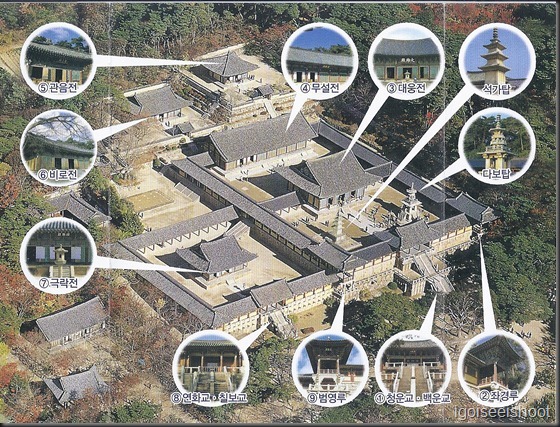7 May 2012
The best time to visit the Bulguksa Temple is in the early morning and that was what we did on our last day in Gyeongju. We took bus #10 from Hyundai Hotel in the Bomun Resort area and alighted near the temple. There was little signage showing the way to the temple from the bus stop. Buddhist temple were mostly located on high ground, so we walked in the general direction that led us uphill. Soon enough, we came to a path, flanked by cherry trees, leading to the temple.
Upon entry, we were greeted by two pairs of fierce looking giant figures on both sides of the entrance gate. The Chinese characters translate into “ Heavenly King Gate”.


We then walked along a footpath leading to the main temple site. The path was well-lined with tall trees with red and green leaves. We crossed over stone bridges laid over ponds and came to the main site. At this time of the morning, the temple was not crowded and the whole place was quite serene and nice.
 Overview of the Bulguksa Temple site from brochure.
Overview of the Bulguksa Temple site from brochure.




Walking around we saw some columns and a stone tub with carved patterns on the outside and lotus flowers in the inside. History of the stone tub is unknown.
One must admire the beautiful and colourful traditional Korean wooden roof architecture.

We passed through a red wooden door and came into the main courtyard.

On the left, there was a Wooden dragon-cum-carp drum. In Chinese mythology, there is myth of a carp transforming into a dragon by crossing the dragon’s gate. This is a cultural symbol for courage, perseverance, and accomplishment.

The main courtyard featured the two famous white granite pagodas in Bulguksa. They were the Seokgatap Pagoda and Dabotap Pagoda.


Dae-ung-jon (Great Enlightenment Hall) - interesting roof shape of the traditional Korean buildings.

We took the opportunity to pay respect to the Buddha and made a small donation to the temple.
Behind the Great Enlightenment Hall, we found another hall with an interesting name. It is called the Mu-Seol-jeon or “No-Word Hall” after translating the Chinese text into English. A sign said “the Moo-sol-jon is a hall for lecturing.
It is called the “Moo-sol” (no-word/non-lecturing) hall because it is impossible to express and reach the essence of the Buddha’s teachings or the depth of Truth though the means of language.”

We then went up a steep flight of steps to the Gwaneumjeon.

Gwaneumjeon – seems to be the highest point within Bulgaksa

Near the Birojeon, we saw the Sarira Pagoda, stone stacks and even a cute little squirrel.



On the way out of the temple, we saw this beautiful combination of green and red leaves in the trees above. Nice Old versus New combination. A perfect end to our visit.
















Hi, I find your post very useful for my trip to Gyeongju. I too intend to stay around Bomun Lake. Will it be the same bus stop and bus number 10 for going back from Bulguksa Temple to Bomun Lake? How frequent are the buses? Is it a long walk from bus stop to temple? Thanks.
ReplyDeleteMore details of taking bus 10 and 11 on this post below. Hope it helps.
Deletehttp://igoiseeishoot.blogspot.sg/2012/10/taking-bus-between-gyeongju-city-and.html?m=
I realised that the links in my post showing the bus routes 10 and 11 is no longer working as the website is taken down. I will try to see if I have a copy of the routes on my PC when I get home. In the meantime, from what I remember, bus 11 is circular route answer is almost opposite to that of bus 10. To get back from the temple to bounce area take bus 11. The bus stop should be opposite side on road when you arrive at the temple but best to check when you get there. The routes for both 10 and 11 are circular. It means 10 will also get you back to bomun area but it will take longer as the bus goes into the city first.
ReplyDeleteI have updated this post
Deletehttp://igoiseeishoot.blogspot.sg/2012/10/taking-bus-between-gyeongju-city-and.html?m=
to include links and diagrams of the bus routes. Hope these help.